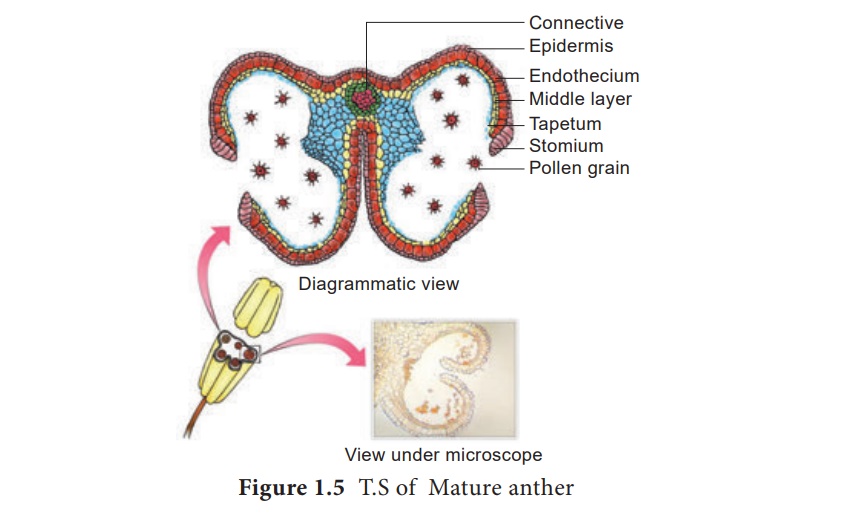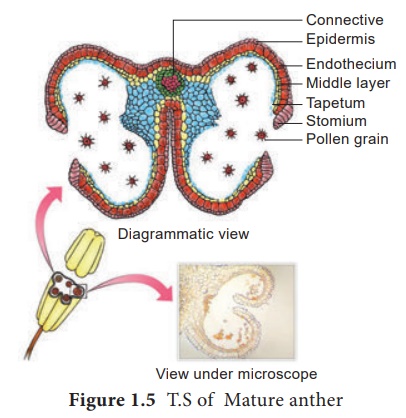Male Reproductive part - Androecium - T.S. of Mature anther | 12th Botany : Chapter 1 : Asexual and Sexual Reproduction in Plants
Chapter: 12th Botany : Chapter 1 : Asexual and Sexual Reproduction in Plants
T.S. of Mature anther

T.S.
of Mature anther
Transverse section of
mature anther reveals the presence of anther cavity surrounded by an anther
wall. It is bilobed, each lobe having 2 theca (dithecous). A typical anther is
tetrasporangiate. The T.S. of Mature anther is given in Figure 1.5.
1. Anther wall
The mature anther wall
consists of the following layers a. Epidermis b. Endothecium c.
Middle layers d. Tapetum.
a. Epidermis: It is single layered
and protective in function. The cells undergo repeated anticlinal
divisions to cope up with the rapidly enlarging internal tissues.
b. Endothecium: It is generally a
single layer of radially elongated cells found below the epidermis. The
inner tangential wall develops bands (sometimes radial walls also) of α
cellulose (sometimes also slightly lignified). The cells are hygroscopic.
In the anthers of aquatic plants, saprophytes, cleistogamous flowers and
extreme parasites endothecial differentiation is absent. The cells along the
junction of the two sporangia of an anther lobe lack these thickenings. This
region is called stomium. This region along with the hygroscopic nature
of endothecium helps in the dehiscence of anther at maturity.

c. Middle layers: Two to three layers of
cells next to endothecium constitute middle layers. They are generally
ephemeral. They disintegrate or get crushed during maturity.
d. Tapetum: It is the innermost
layer of anther wall and attains its maximum development at the tetrad
stage of microsporogenesis. It is derived partly from the peripheral wall layer
and partly from the connective tissue of the anther lining the anther locule.
Thus, the tapetum is dual in origin. It nourishes the developing sporogenous
tissue, microspore mother cells and microspores. The cells of the tapetum may
remain uninucleate or may contain more than one nucleus or the nucleus may
become polyploid. It also contributes to the wall materials, sporopollenin, pollenkitt,
tryphine and number of proteins that control incompatibility reaction .Tapetum
also controls the fertility or sterility of the microspores or pollen grains.
There are two types of
tapetum based on its behaviour. They are:
Secretory tapetum (parietal/glandular/ cellular):
The tapetum retains the original position and cellular integrity and nourishes
the developing microspores.
Invasive tapetum (periplasmodial): The cells loose their inner tangential and radial walls and the protoplast of all tapetal cells coalesces to form a periplasmodium.
Functions of Tapetum:
·
It supplies nutrition to the developing microspores.
·
It contributes sporopollenin through ubisch bodies thus
plays an important role in pollen wall formation.
·
The pollenkitt material is contributed by tapetal cells and is
later transferred to the pollen surface.
Exine proteins
responsible for ‘rejection reaction’ of the stigma are present in
the cavities of the exine. These proteins are derived from tapetal
cells.
2. Anther Cavity : The anther cavity is
filled with microspores in young stages or with pollen grains at
maturity. The meiotic division of microspore mother cells gives rise to
microspores which are haploid in nature.
3. Connective: It is the column of
sterile tissue surrounded by the anther lobe. It possesses vascular
tissues. It also contributes to the inner tapetum.
Related Topics